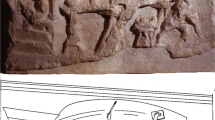Abstract
This article aims to present a classification of contemporary graffiti to support the study of prehistoric art. The classification is based on 2-year field observations of both completed and newly created works of contemporary graffiti and street art. The classification is oriented to the result of the creative act in view of its communicative significance. The scientific approach does not aim to create direct parallels between specific artistic samples, but to study the basic principles, stages, and starting points of the creative act. Thanks to the classification, on the principle of analogy, a series of questions have been prepared and addressed to archaeologists, cultural anthropologists, and art critics with a greater degree of training in the field of prehistoric art. The current research seeks to explain some aspects of prehistoric art through modern graffiti. This approach is not intended to negate the scientific hypotheses and results achieved so far in the field of Archaeology and History of Art but to help scholars of prehistoric art study to ask or reformulate a series of questions that will contribute to a more comprehensive view and understanding of prehistoric art.







Similar content being viewed by others
Availability of Data and Materials
Not applicable.
References
Asman, Y. (2001). Kulturnata Pamet: Pismenost, Pamet i Polit. Identichnost v Rannite Visokorazviti Kulturi. Obrazovanie i nauka.
Baird, J. A., & Taylor, C. (2016). Ancient graffiti. In J. I. Ross (Ed.), Routledge handbook of graffiti and street art (pp. 17–26). Routledge.
Booker, C. (2004). The seven basic plots of literature. Continuum.
Clottes, J. (2016). What is Paleolithic art?: Cave paintings and the dawn of human creativity. The University Of Chicago Press.
Davidson, I. (2012). Symbolism and becoming a hunter-gatherer. In J. Clottes (Ed.), L’art pléistocène dans le monde (pp. 1689–1705). Société Préhistorique Ariège-Pyrénées.
Davidson, I. (1997). The power of pictures. In M. Conkey, O. Soffer, D. Stratmann, & N. G. Jablonski (Eds.), Beyond art: Pleistocene image and symbol (pp. 128–158).
Ferrell, J. (2016). Graffiti, street art and the politics of complexity. In J. I. Ross (Ed.), Routledge handbook of graffiti and street art (pp. xxx–xxxviii). Routledge.
Gottlieb, L. (2008). Graffiti art styles : A classification system and theoretical analysis. McFarland & Company Inc.
LDNGraffiti. (2014). Banksy vs Robbo – 'Turf War' Timeline. http://ldngraffiti.co.uk/graffiti/banksy-vs-team-robbo-timeline/
Prop, V. (1995). Morfologia na Prikazkata. Hristo Botev.
Ragazzoli, C., Harmanşah, Ö., Salvador, C., & Frood, E. (2019). Scribbling through history: Graffiti, places and people from antiquity to modernity. Bloomsbury Academic.
Stoychev, T. (2005). Sklano Izkustvo - Obshta Klasifikatsia. AGATO.
Zagorov, V. (2022). Dicks or hearts. What can modern wall self-expression tell us? BBDS - Black Book: Drawing and Sketching, 3(1), 6–18. https://doi.org/10.48619/bbds.v3i1.589
Zagorov, V., & Hristov, H. (2021). Motivi I Podbudi pri savremennoto gradsko steno izkustvo. In E. Savova, R. Yotova, & D. Stoyanova (Eds.), Ustoychivi Politiki za Integralno Sahranyavane na Materialnoto i Nematerialnoto Kulturno Nasledstvo (pp. 27–33). Za bukvite - O pismeneh.
Acknowledgements
The project team would like to thank the Helictit Speleology Club, Sofia, Bulgaria, Sofia Graffiti Tour, GRAFFstvoto and 0511.
Funding
This research was conducted with the support of the Bulgarian National Science Fund under the project: Trends and Parallels in Prehistoric Rock and Contemporary Street Art– BNSF KP-06-M45/2.
Author information
Authors and Affiliations
Contributions
Conceptualization: Vasil Zagorov; Methodology: Vasil Zagorov; Formal analysis and investigation: Vasil Zagorov, Hristo Hristov; Writing ‐ original draft preparation: Vasil Zagorov; Writing ‐ review and editing: Vasil Zagorov, Hristo Hristov; Resources: Vasil Zagorov, Hristo Hristov.
Corresponding author
Ethics declarations
Ethical Approval
This study does not contain any studies with human or animal subjects performed by any of the authors.
Competing Interests
The authors have no competing interests to declare that are relevant to the content of this article.
Additional information
Publisher's Note
Springer Nature remains neutral with regard to jurisdictional claims in published maps and institutional affiliations.
Rights and permissions
Springer Nature or its licensor (e.g. a society or other partner) holds exclusive rights to this article under a publishing agreement with the author(s) or other rightsholder(s); author self-archiving of the accepted manuscript version of this article is solely governed by the terms of such publishing agreement and applicable law.
About this article
Cite this article
Zagorov, V., Hristov, H. Contemporary Graffiti as a Tool for Studying Prehistoric Art: A Classification Attempt. Hu Arenas (2023). https://doi.org/10.1007/s42087-023-00369-z
Received:
Revised:
Accepted:
Published:
DOI: https://doi.org/10.1007/s42087-023-00369-z




